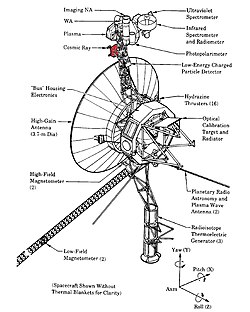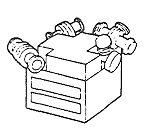

Cosmic Ray Subsystem (CRS, or Cosmic Ray System)[1] is an instrument aboard the Voyager 1 and Voyager 2 spacecraft of the NASA Voyager program, and it is an experiment to detect cosmic rays.[2][3] The CRS includes a High-Energy Telescope System (HETS), Low-Energy Telescope System (LETS), and The Electron Telescope (TET).[4] It is designed to detect energetic particles and some of the requirements were for the instrument to be reliable and to have enough charge resolution.[5] It can also detect the energetic particles like protons from the Galaxy or Earth's Sun.[1]
As of 2019, CRS is one of the active remaining instruments on both Voyager spacecraft, and it is described by as being able to detect electrons from 3–110 MeV and cosmic ray nuclei 1–500 MeV/n.[6] All three systems used solid-state detectors.[7] CRS is one of the five fields and particle experiments on each spacecraft, and one of the goals is to gain a deeper understanding of the solar wind.[8] Other objects of study including electrons and nuclei from planetary magnetospheres and from outside the solar system.[9]
In the summer of 2019, the heater for the CRS on Voyager 2 was turned off to save power, however, although it cooled off it was still returning data at a new lower temperature outside its original operating range.[10] The amount of power on the Voyager spacecraft has been slowly decreasing, so various items of equipment are turned off to save power.[10]
- ^ a b Team, Voyager Cosmic Ray Subsystem. "OBJECTIVES". voyager.gsfc.nasa.gov. Retrieved 2017-01-13.
- ^ "NASA - NSSDCA - Experiment - Details for Voyager 2". nssdc.gsfc.nasa.gov. Retrieved 2017-01-13.
- ^ "NASA - NSSDCA - Experiment - Details for Voyager 1". nssdc.gsfc.nasa.gov. Retrieved 2017-01-13.
- ^ Cite error: The named reference
voyagercsswas invoked but never defined (see the help page). - ^ Stone, E. C.; Vogt, R. E.; McDonald, F. B.; Teegarden, B. J.; Trainor, J. H.; Jokipii, J. R.; Webber, W. R. (1977). "1977SSRv...21..355S Page 355". Space Science Reviews. 21 (3): 355. Bibcode:1977SSRv...21..355S. doi:10.1007/BF00211546. S2CID 121390660.
- ^ JPL.NASA.GOV. "Voyager - The Interstellar Mission". voyager.jpl.nasa.gov. Retrieved 2017-01-13.
- ^ Team, Voyager Cosmic Ray Subsystem. "INSTRUMENTS". voyager.gsfc.nasa.gov. Retrieved 2017-02-02.
- ^ Evans, Ben; Harland, David M. (2008). NASA's Voyager Missions: Exploring the Outer Solar System and Beyond. Springer Science & Business Media. p. 67. ISBN 978-1-85233-745-2.
- ^ Doody, Dave (2010). Deep Space Craft: An Overview of Interplanetary Flight. Springer Science & Business Media. p. 218. ISBN 978-3-540-89510-7.
- ^ a b "A New Plan for Keeping NASA's Oldest Explorers Going". NASA/JPL. Retrieved 2019-09-22.